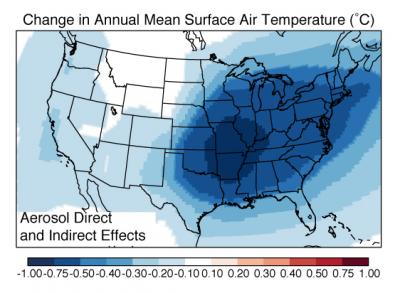Over the days, it is has been known that greenhouse gases such as methane and carbon dioxide warm the surface of the earth. However, a new study has demonstrated that particulate pollution amplified the cooling effect at the surface.
 "This figure illustrates the mean effect on surface temperature, during the period 1970-1990, of particulate pollution. The central region was cooled by as much as 1 degree Celsius.Credit: Image courtesy of Eric Liebensberger"
"This figure illustrates the mean effect on surface temperature, during the period 1970-1990, of particulate pollution. The central region was cooled by as much as 1 degree Celsius.Credit: Image courtesy of Eric Liebensberger"
Researchers from the Harvard School of Engineering and Applied Sciences (SEAS) have found that in the late 20th century, tiny particles in air formed a "warming hole" on the eastern US, which is a cold region and where the global warming impact was delayed temporarily.
The tiny particles consist of sulfates, which are formed from sulfur emissions of coal-fired power plants. Particulate pollution has a very short lifespan, around one week, when compared to greenhouse gases. Hence, it is not evenly distributed on earth.
The study was based on the data collected from a mix of two Earth model systems. The GEOS-Chem model provided the pollution data. This model was initially developed at Harvard and after several updates, has become an international standard for designing pollution. The common circulation model from NASA's Goddard Institute for Space Studies offered the climate data.
The findings illustrated that cooling increased due to the communication between particles and clouds. Pollution particles can work as nucleation sites for cloud droplets. In turn, the droplets reflect additional sunlight than individual particles.
The study provides complete information on the methods affecting regional climate change. Further, the study provides important suggestions for the future climate in industrial countries, such as China, where air quality regulations are not yet been executed like the US.
The study has been published in the journal, Atmospheric Chemistry and Physics.